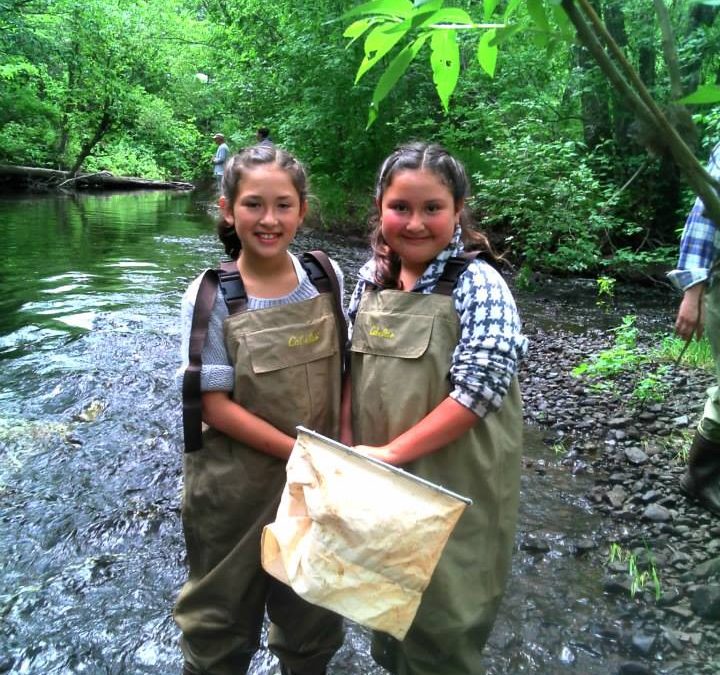By Caitlin E. Williamson, Natural Resources Foundation of Wisconsin
 Bad River Youth Outdoors is gearing up for its third summer of watershed education with tribal youth from the Bad River Ojibwe Indian Reservation, a four-week program designed to get kids outside and to learn more about the waterways of Lake Superior and the Bad River watershed. In its first year, BRYO received funding to purchase equipment from the Natural Resources Foundation’s C.D. Besadny Conservation Grant Program.
Bad River Youth Outdoors is gearing up for its third summer of watershed education with tribal youth from the Bad River Ojibwe Indian Reservation, a four-week program designed to get kids outside and to learn more about the waterways of Lake Superior and the Bad River watershed. In its first year, BRYO received funding to purchase equipment from the Natural Resources Foundation’s C.D. Besadny Conservation Grant Program.

Two girls monitoring water quality at Tyler Forks. (Photo courtesy of Bad River Youth Outdoors)
Established as a pilot program to provide a cross-cultural educational experience combining environmental education with outdoor recreation, Bad River Youth Outdoors has proven itself a successful model. The program serves kids between ages 11 and 17, aiming to get them outside to learn about the ecological and cultural aspects of the waters in their homeland.
“One of the goals of Bad River Youth Outdoors is to get these kids to fall in love with their home,” said Jessie Conaway, PhD in Environment & Resources from UW-Madison’s Nelson Institute for Environmental Studies. As part of her dissertation, Conaway worked with the Bad River tribe to develop the program. “BRYO is a really cool model because it incorporates both native and western science in teaching tribal youth about the Bad River watershed and Lake Superior.”

Kayaking in the Bad River Watershed. Bad River Youth Outdoors exposes tribal youth to outdoor recreation, and the important waterways that make up their home. (Photo courtesy of BRYO)
By exposing kids to the outdoors with fun, hands-on activities such as kayaking and camping, BRYO allows them to become comfortable and familiar with the reservation for recreating. The program also introduces tribal youth to natural resource and conservation jobs. Each summer, visiting instructors from the Bad River Natural Resources Department and the Great Lakes Indian Fish & Wildlife Commission teach youth about their own professions, local natural resource issues, and engage them in hands-on projects, such as removing invasive cattails on the Kakagon River, or visiting piping plover nesting sites in the Apostle Islands.
In the process, the kids learn about the ecological and cultural perspectives of the place they are stewarding, and are making a contribution to the health of that resource. Another project included monitoring water quality on the Tyler Forks, part of the Ojibwe’s off reservation ceded territories.
“The Ojibwe have treaty rights to hunt, fish, and gather, but there also is an implied right to steward those ceded lands, so they can manage and protect those resources and continue to exercise their rights,” Conaway said.

Bad River Kakagon Estuary, the largest intact wild rice estuary. An ecological and cultural treasure that tribal youth steward as part of Bad River Youth Outdoors. (Photo by Ruth Oppedahl)
BRYO also emphasizes community outreach. Other activities during the summer include a beach clean-up, and teaching other tribal youth to canoe and kayak during community events. Young adults from the community become certified canoe and kayak instructors to help teach the program.
“Youth education is such a priority in Ojibwe communities,” Conaway said. “It’s important to grow new leaders and educate youth about cultural perspectives, and water and land. Bad River Youth Outdoors is a partnership intended to build durability and sustainability for the tribe.”

Bad River (Photo by Caitlin Williamson)
Bad River Youth Outdoors is an inspiring concept, and proven to be successful for promoting ecosystem and community health. Mino nibiwan, mino bimaadiziwin. Good waters, good life.
Conaway describes maps that the students sketched of the Bad River watershed, before and after attending BRYO. The pre-summer maps emphasized built environments: towns, neighborhoods, roads. However, the post-summer maps had many more hydrology features: the Bad River, Kakagon Sloughs, Tyler Forks, where those waterways flow into Lake Superior. And talking with the youth, many of them want to instruct for the program in the future.
For more information on Bad River Youth Outdoors, visit the Facebook page and Story Map website.
